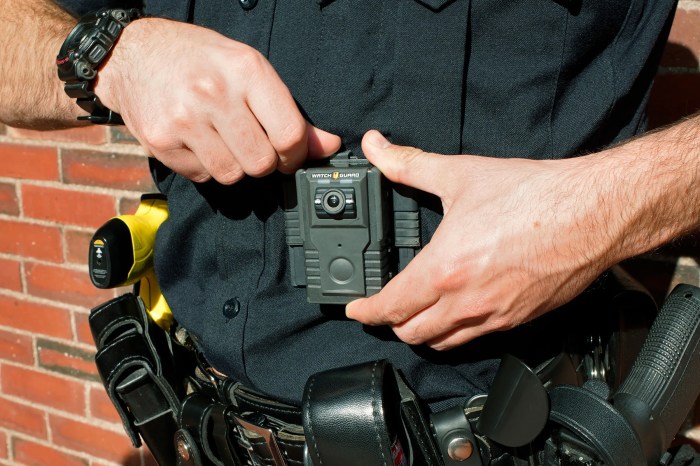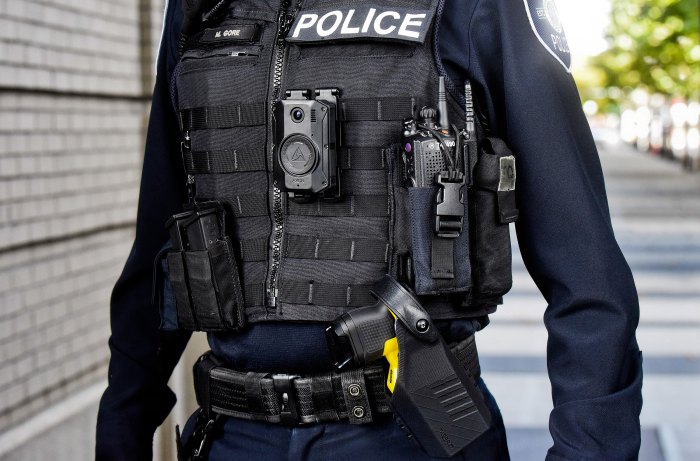Background and Context
The implementation of police body cameras represents a significant shift in law enforcement practices, driven by a confluence of factors that have propelled their adoption across the globe. While the concept of recording police interactions isn’t entirely new, the widespread use of body cameras has been a relatively recent development, marked by a series of technological advancements, legal considerations, and societal demands.
Evolution of Police Body Cameras
The evolution of police body cameras can be traced back to the early 2000s, with the emergence of compact, affordable video recording devices. Early adopters were primarily small police departments or individual officers seeking to document interactions with the public, often for self-protection purposes. The initial focus was on capturing evidence of potential misconduct by officers or citizens, as well as providing a record of events in case of disputes.
Motivations for Implementation
The initial motivations behind the implementation of police body cameras were multifaceted.
- Increased Accountability and Transparency: Body cameras were seen as a means to increase transparency and accountability in law enforcement. By providing an objective record of interactions, they could potentially reduce instances of misconduct and provide evidence in cases of disputed events.
- Improved Evidence Collection: Body cameras offered a valuable tool for evidence collection in criminal investigations. The recordings could capture crucial details, such as witness statements, suspect actions, and crime scene evidence, enhancing the effectiveness of investigations.
- Officer Safety and Protection: The presence of a body camera could act as a deterrent to aggressive behavior by individuals, potentially reducing the risk of assaults on officers. The recordings could also provide valuable evidence in cases of officer-involved shootings or other incidents involving use of force.
Factors Influencing Widespread Adoption
Several key factors have influenced the widespread adoption of body cameras in recent years.
- High-Profile Cases and Public Demand: A series of high-profile cases involving police misconduct and shootings, often captured on citizen-made videos, sparked public outcry and demands for greater transparency and accountability in law enforcement. These incidents highlighted the need for objective evidence and contributed to the growing public support for body cameras.
- Technological Advancements: Advancements in technology have made body cameras more affordable, smaller, and more user-friendly. The development of high-resolution cameras, long battery life, and robust data storage capabilities have made them a practical and effective tool for law enforcement agencies.
- Legal and Policy Developments: In many jurisdictions, legal and policy frameworks have been developed to address the use of body cameras, including regulations on data storage, privacy concerns, and access to recordings. These developments have provided a foundation for the widespread adoption of body cameras by law enforcement agencies.
Benefits and Challenges of Wearable Cameras: Police Experimenting With Wearable Cameras
Wearable cameras, also known as body cameras, have become increasingly common among law enforcement agencies around the world. Their use has sparked a debate about their potential benefits and challenges, with supporters arguing that they promote transparency and accountability, while critics raise concerns about privacy and potential misuse.
Potential Benefits of Wearable Cameras, Police experimenting with wearable cameras
Wearable cameras offer a number of potential benefits for law enforcement, including:
- Increased Transparency and Accountability: Body cameras provide an objective record of interactions between police officers and the public. This can help to clarify events and resolve disputes, holding officers accountable for their actions and promoting public trust.
- Reduced Use of Force: Studies have shown that the presence of body cameras can lead to a reduction in the use of force by police officers. This may be due to the awareness that their actions are being recorded, leading to more cautious and restrained behavior.
- Improved Evidence Gathering: Body cameras can capture valuable evidence in criminal investigations, such as statements, actions, and physical evidence. This can help to build stronger cases and improve conviction rates.
- Enhanced Officer Safety: Body cameras can serve as a deterrent to criminal activity and provide valuable evidence in cases of officer assault.
Potential Challenges and Ethical Considerations
While body cameras offer numerous potential benefits, their use also raises several challenges and ethical considerations:
- Privacy Concerns: The use of body cameras raises concerns about the privacy of individuals captured on video. Questions arise regarding data storage, access, and the potential for misuse of sensitive information.
- Potential for Bias: The way body camera footage is interpreted can be influenced by biases, both conscious and unconscious. This can lead to inaccurate or unfair judgments about the actions of officers and individuals captured on video.
- Data Storage and Management: Storing and managing large amounts of body camera footage can be a logistical challenge. Secure storage systems and clear policies are needed to ensure data integrity and prevent unauthorized access.
- Cost and Implementation: The purchase, maintenance, and training associated with body cameras can be expensive, particularly for smaller law enforcement agencies.
Impact of Wearable Cameras on Police-Community Relations
The use of body cameras has the potential to improve police-community relations by promoting transparency and accountability. However, the impact can be complex and depends on how cameras are implemented and used.
- Building Trust: Body cameras can help to build trust between police and the community by providing evidence to support or refute allegations of misconduct.
- Increased Transparency: The availability of body camera footage can help to inform the public about police practices and procedures, fostering a more transparent and accountable law enforcement system.
- Reducing Conflicts: The knowledge that interactions are being recorded can help to de-escalate situations and reduce the potential for conflict between officers and the public.
- Challenges and Concerns: Some communities may be hesitant to embrace body cameras due to concerns about privacy or the potential for misuse of footage. It’s crucial to address these concerns through open dialogue and transparent implementation.
Technological Advancements and Future Directions
The landscape of wearable camera technology is rapidly evolving, driven by advancements in miniaturization, connectivity, and artificial intelligence. These innovations are shaping the future of law enforcement, promising enhanced accountability, improved safety, and more efficient investigations.
Integration with Artificial Intelligence
The integration of artificial intelligence (AI) is revolutionizing the capabilities of body cameras. AI algorithms can analyze video footage in real-time, identifying potential threats, recognizing individuals, and detecting suspicious activities. This can assist officers in making quicker and more informed decisions, particularly in high-stress situations.
- Facial Recognition: AI-powered facial recognition software can identify individuals captured on body camera footage, potentially linking suspects to past crimes or providing crucial information in missing persons cases. For example, in a recent case, facial recognition technology helped identify a suspect in a robbery by matching his image to a database of known criminals. This led to his swift apprehension.
- Object Detection: AI algorithms can identify and classify objects in video footage, such as weapons, drugs, or contraband. This can assist officers in identifying potential threats and providing evidence in criminal investigations. In a real-world scenario, AI-powered object detection helped officers locate a hidden weapon during a search warrant, leading to the arrest of a suspect.
- Audio Analysis: AI can transcribe and analyze audio recordings from body cameras, identifying key phrases, detecting threats, and even recognizing emotions. This can provide valuable evidence in investigations and help officers understand the context of an incident. For instance, AI-powered audio analysis has been used to identify threats made against officers during a traffic stop, leading to the prosecution of the offender.
Data Analytics and Predictive Policing
Body camera footage, coupled with AI-powered data analytics, can be used to analyze trends and patterns in crime, allowing law enforcement agencies to anticipate potential threats and deploy resources more effectively.
- Crime Hotspots: By analyzing the location and time of incidents captured on body cameras, law enforcement can identify crime hotspots and deploy patrols accordingly. This can help prevent future crimes and improve public safety.
- Officer Behavior: Data analytics can be used to assess officer behavior, identifying patterns of excessive force or racial bias. This information can be used to improve training and accountability measures.
- Predictive Policing: By analyzing historical data from body cameras and other sources, law enforcement agencies can use AI to predict future crime trends and deploy resources proactively. While controversial, this technology has the potential to prevent crime and improve public safety.
Enhanced Connectivity and Data Sharing
Advancements in wireless communication technologies are enabling body cameras to stream video footage in real-time to command centers and other authorized personnel. This can provide crucial situational awareness and support during critical incidents.
- Real-Time Monitoring: Body camera footage can be streamed live to command centers, allowing supervisors to monitor situations in real-time and provide support to officers. This can be particularly useful in high-risk situations, such as hostage negotiations or active shooter incidents.
- Data Sharing: Body camera footage can be easily shared with other agencies, prosecutors, and defense attorneys, streamlining investigations and improving collaboration.
- Cloud Storage: Body camera footage can be stored securely in the cloud, providing easy access and reducing the risk of data loss.
Police experimenting with wearable cameras – The use of wearable cameras in law enforcement is a complex issue with no easy answers. While they hold the promise of increased transparency and accountability, it’s crucial to address the potential downsides and ensure that these technologies are used ethically and responsibly. As we move forward, it’s important to have open discussions about the role of body cameras in society and how to ensure that they are implemented in a way that benefits both law enforcement and the public.
Police experimenting with wearable cameras is a hot topic, with debates raging about privacy and transparency. But while cops are trying to capture every angle, Twitter is upgrading its direct messaging feature, making it easier to send private messages. Perhaps one day, even the police will be able to use Twitter’s upgraded messaging to share evidence directly with their superiors, creating a streamlined and secure system for law enforcement.
 Standi Techno News
Standi Techno News

